This report summarizes incidence rates and trends of sexually transmitted infections (STIs) from 2014 to 2022 among active component service members of the U.S. Armed Forces. The data compiled for this report are derived from medical surveillance of chlamydia, gonorrhea, and syphilis as nationally notifiable diseases. Case data for 2 additional STIs, human papilloma virus (HPV) and genital herpes simplex virus (HSV), are also presented. Since 2019 case rates for all STIs have declined, excluding syphilis, which declined briefly but rose among male and female service members by approximately 40% between 2020 and 2022. Overall age- and gender-adjusted case rates for chlamydia, gonorrhea, and syphilis remain somewhat higher within the U.S. Armed Forces than among the general U.S. population, which may be due to factors including mandatory screening, more complete reporting, incomplete adjustment for age distribution, and inequitable comparisons between the active duty military and entire U.S. population. While case rates among female service members for chlamydia, gonorrhea, HPV, and HSV are significantly higher, syphilis rates display a male preponderance for all except the youngest age group. Social restrictions during the COVID-19 pandemic may have contributed to declines in true case rates and screening coverage.
What are the new findings?
STI rates have declined since 2019, except for syphilis, which has increased for 2 consecutive years. These trends may be partially influenced by changes in screening coverage or behavior associated with the COVID-19 pandemic. Future analyses of screening rates are warranted to assess a true decline in incidence and examine the recent increase in syphilis reports.
What is the impact on readiness and force health protection?
To assist service leader and medical corps planning and assessment of STI prevention and control measures for operational readiness, this report provides an updated epidemiologic profile of the most commonly reported STIs. STIs can adversely affect service member ability and availability for duty performance and result in serious medical sequelae if untreated. Continued behavioral and educational interventions are needed to mitigate STI risk among military service members.
Background
In 2021, sexually transmitted infections (STIs) represented 1 of the highest health care burdens attributable to infectious diseases (other than COVID-19) among active component service members of the U.S. Armed Forces.1 The National Academies of Sciences, Engineering and Medicine recently convened a committee to provide recommendations for STI prevention and control in the U.S., concluding that military recruits and active duty service members required focused consideration.2 While multiple and interrelated factors influence STI risk within military populations,3 the strongest risk factors are age and sex. The military population is young (mean age 26) and predominantly male (85%), so its rates are not directly comparable to the general U.S. population unless adjusted for these demographics. Previous reports have found higher incidence rates of all STIs in specific ethnic/racial groups, which may represent a true difference, or may be an artifact of the categories used for those analyses.
The Centers for Disease Control and Prevention (CDC) publishes annual summaries of national surveillance data for notifiable diseases covered by federally-funded control programs, including Chlamydia trachomatis (chlamydia), Neisseria gonorrhoeae (gonorrhea), and Treponema pallidum (syphilis). Preliminary data from the National Notifiable Diseases Surveillance System indicate that these 3 STIs continued to increase into the second year of the COVID-19 pandemic, underscoring the importance of continued prevention and control programs.4 Although these 3 relatively common bacterial STIs are curable with antibiotics, there is continued concern about the threat of multidrug resistance.5–7
Common viral STIs in the U.S. also include infections caused by human papillomavirus (HPV) and genital herpes simplex virus (HSV). Studies assessing the National Health and Nutrition Examination Survey (NHANES) provide prevalence estimates for adolescents and young adults ages 15-24, estimating 1.3 million prevalent HSV-2 infections and 9.0 million infected with at least 1 disease-associated HPV type in 2018.8 Neither HPV nor HSV viral infections are curable with antibiotics; however, suppression of recurrent herpes is attainable using antiviral medication, and a vaccine prevents infection from 4 of the most common HPV serotypes as well as 5 cancerous types.9
This report presents an epidemiologic profile for STIs among active component service members from 2014 to 2022, updating previous MSMR articles.10,11 Data are presented for 5 common STIs: chlamydia, gonorrhea, syphilis, HPV, and HSV. This year marks the first where rates are expressed per 100,000 to match CDC reports; thus, any comparisons to prior MSMR reports using rates per 10,000 should account for this methodologic change.
Methods
The surveillance population for this report comprises all active component service members of the U.S. Army, Navy, Air Force, or Marine Corps who served at any time during the surveillance period of January 1, 2014 to December 31, 2022. STI diagnoses were ascertained from medical administrative data and reports of notifiable medical events routinely provided to the Armed Forces Health Surveillance Division (AFHSD) and maintained in the Defense Medical Surveillance System (DMSS) for health surveillance. STI cases were also derived from positive laboratory test results recorded in the Health Level 7 (HL7) chemistry and microbiology databases maintained by the EpiData Center at Defense Centers for Public Health-Portsmouth (DCPH-P).
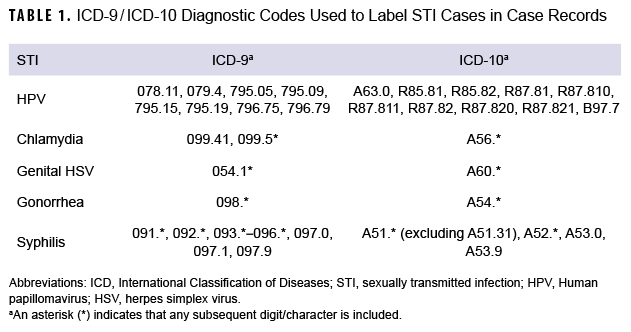 Each service member's number of days in active service was determined and then aggregated to a total for all service members in each calendar year. The resultant annual totals were expressed as person-years (p-yrs) of service and used as the denominators for calculating annual incidence rates. Person-time not considered time at risk for each STI (i.e., the 30 days following each incident chlamydia or gonorrhea infection and all person-time following the first diagnosis, medical event report, or positive laboratory test of HSV, HPV, or syphilis) was excluded. An incident case of chlamydia was defined by either 1) a case-defining diagnosis (Table 1) in the first or second diagnostic position in a record of an outpatient or in-theater medical encounter, 2) a confirmed notifiable disease report, or 3) a positive laboratory test (of any specimen source or test type). An incident case of gonorrhea was similarly defined by 1) a case-defining diagnosis in the first or second diagnostic position of an inpatient, outpatient, or in-theater encounter record, 2) a confirmed notifiable disease report, or 3) a positive laboratory test (any specimen source or test type). For both chlamydia and gonorrhea, an individual could be counted as having a subsequent case only if more than 30 days occurred between the dates recorded for each case-defining diagnosis.
Each service member's number of days in active service was determined and then aggregated to a total for all service members in each calendar year. The resultant annual totals were expressed as person-years (p-yrs) of service and used as the denominators for calculating annual incidence rates. Person-time not considered time at risk for each STI (i.e., the 30 days following each incident chlamydia or gonorrhea infection and all person-time following the first diagnosis, medical event report, or positive laboratory test of HSV, HPV, or syphilis) was excluded. An incident case of chlamydia was defined by either 1) a case-defining diagnosis (Table 1) in the first or second diagnostic position in a record of an outpatient or in-theater medical encounter, 2) a confirmed notifiable disease report, or 3) a positive laboratory test (of any specimen source or test type). An incident case of gonorrhea was similarly defined by 1) a case-defining diagnosis in the first or second diagnostic position of an inpatient, outpatient, or in-theater encounter record, 2) a confirmed notifiable disease report, or 3) a positive laboratory test (any specimen source or test type). For both chlamydia and gonorrhea, an individual could be counted as having a subsequent case only if more than 30 days occurred between the dates recorded for each case-defining diagnosis.
An incident case of syphilis was defined by either 1) a qualifying ICD-9 or ICD-10 code in the first, second, or third diagnostic position of a hospitalization record, 2) at least 2 outpatient or in-theater encounters within 30 days with a qualifying ICD-9 or ICD-10 code in the first or second position, 3) a confirmed notifiable disease report for any type of syphilis, or 4) a record of a positive polymerase chain reaction or treponemal laboratory test. Stages of syphilis (primary, secondary, late, latent) could not be distinguished because HL7 laboratory data do not allow for stage differentiation, and because a high degree of misclassification is associated with ICD diagnosis code usage for stage determination.12,13 An individual could be considered an incident case of syphilis only once during the surveillance period; those with evidence of prior syphilis infection were excluded.
Incident cases of HSV were identified by either 1) a requisite International Classification of Diseases, 9th or 10th Revision (ICD-9 or ICD-10, respectively) code in either the first or second diagnostic positions of an outpatient or in-theater encounter record or 2) a positive laboratory test from a genital specimen source. Antibody tests were excluded because they do not allow distinction between genital and oral infections. Incident cases of HPV were similarly identified by either 1) the presence of the requisite ICD-9 or ICD-10 codes in either the first or second diagnostic positions of an outpatient or in-theater encounter record or 2) a positive laboratory test from any specimen source or test type. Outpatient encounters for HPV with evidence of HPV immunization within 7 days before or after the encounter date were excluded, as were outpatient encounters with a procedural or Current Procedural Terminology (CPT) code indicating HPV vaccination, as such encounters were potentially related to vaccination administration. An individual could be counted as an incident case of HSV or HPV only once during the surveillance period. Individuals with HSV or HPV infection diagnoses before the surveillance period were excluded. Incidence rates were calculated as incident cases of a given STI per 100,000 p-yrs of active component service, with percent changes in incidence calculated by unrounded rates.
Results
Between 2014 and 2022, the number of incident chlamydia infections among active component service members exceeded the other 4 STIs combined, and was 4.4 times the total number of genital HPV infections—the next most frequently identified STI during this period (Table 2).
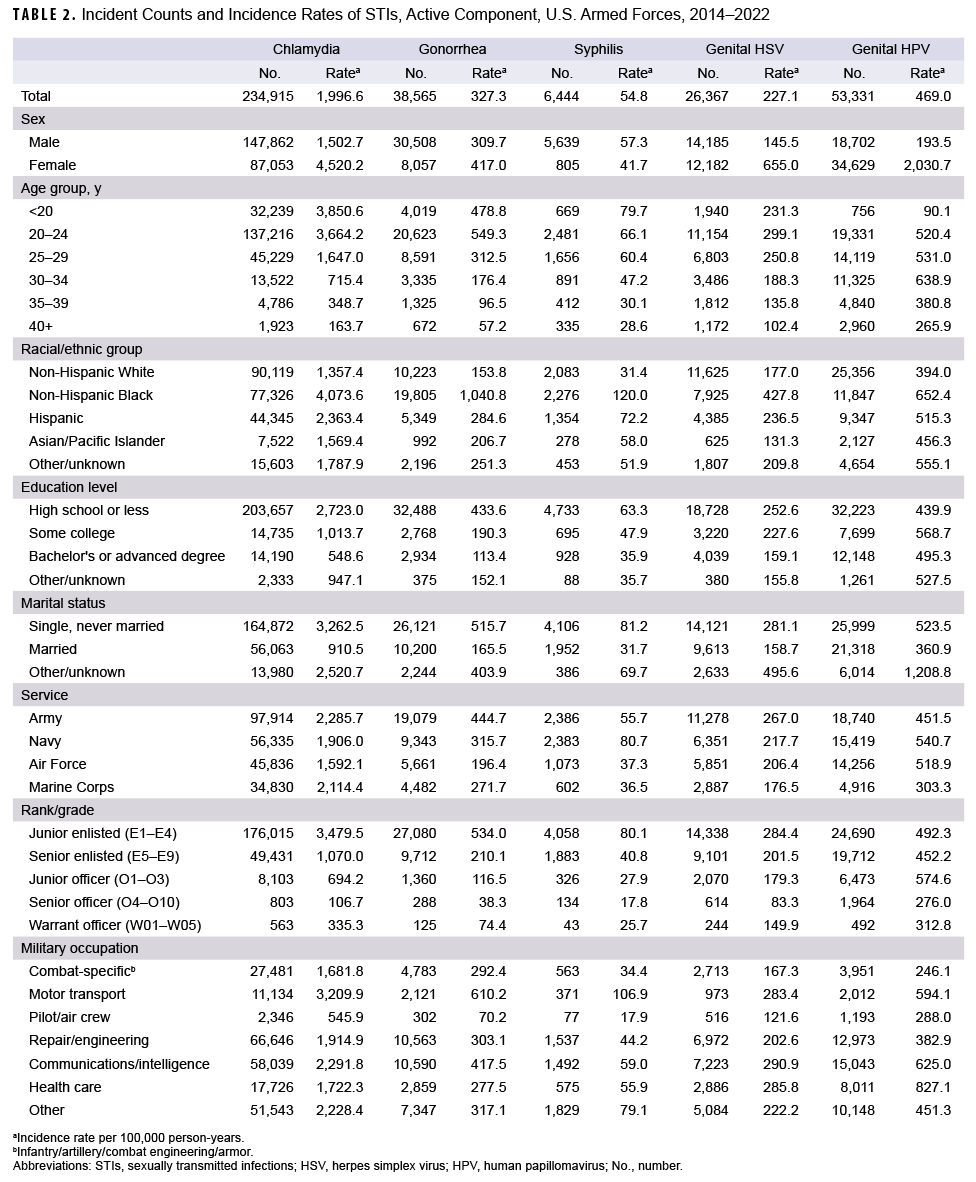
In 2022, 34% of syphilis cases, 71% of gonorrhea cases, and 87% of chlamydia cases that were qualified by laboratory or medical encounter data had a corresponding reportable medical event (RME). Table 2 provides the crude, unadjusted STI rates by other sociodemographic variables including service, age, education, marital status, rank/grade, and occupation. Patterns of incidence rates over time for each specific STI are described in subsequent subsections.
Chlamydia
Annual chlamydia rates among all active component members increased 53.2% between 2014 and 2019, with rates among both women and men peaking in 2019 (5,461.1 per 100,000 p-yrs and 1,883.4 per 100,000 p-yrs, respectively) (Figure 1a; Figure 1b).
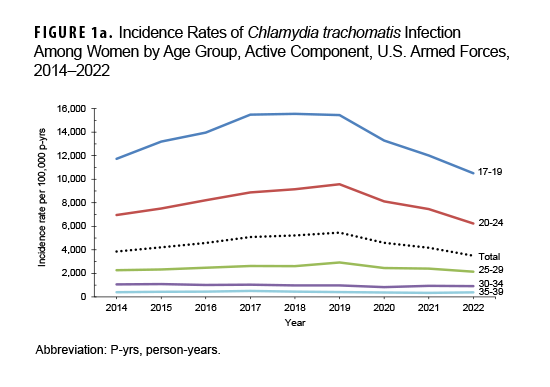
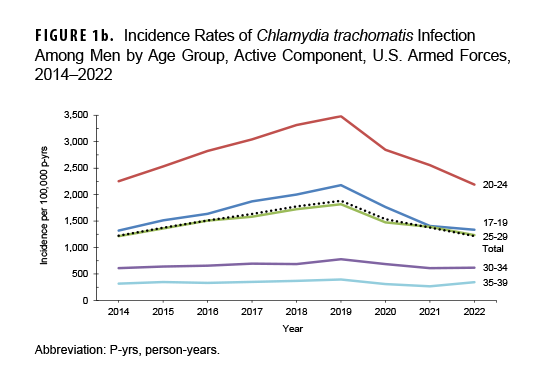
From 2019 to 2022, chlamydia rates for both male and female service members declined by 35.0%. The younger age categories constituted a majority of this decline. Among women, non-Hispanic Black service members younger than age 25 demonstrated the largest absolute rate change, declining from a peak of 15,402.9 per 100,000 p-yrs in 2019 to 9,951.5 per 100,000 p-yrs in 2022 (Figure 2a). The relative change in chlamydia rates among female service members younger than age 25 was comparable among racial/ethnic categories, declining approximately 33-37% between 2019 and 2022. This trend was also comparable among male service members under 25 years of age, whose rates declined by approximately 35-40% in each racial/ethnic category during the same period (Figure 2b).
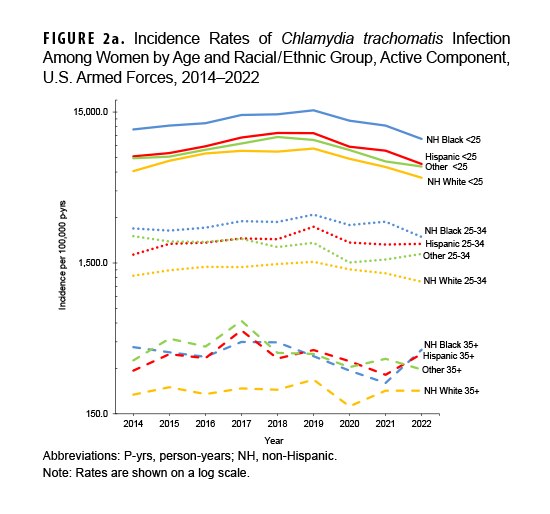
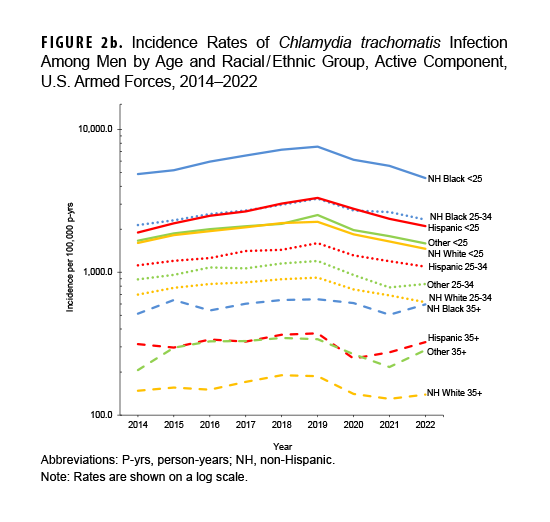
Gonorrhea
Between 2014 and 2022, the crude annual incidence rate of gonorrhea increased 28.7%; however, after peaking in 2019 (370.2 per 100,000 p-yrs), the rate declined to 324.7 per 100,000 p-yrs in 2022. During the last 5 years of the surveillance period (2018 to 2022), more substantial declines were observed among women (490.5 to 376.5 per 100,000 p-yrs) than men (346.2 to 313.7 per 100,000 p-yrs) (Figure 3a; Figure 3b).
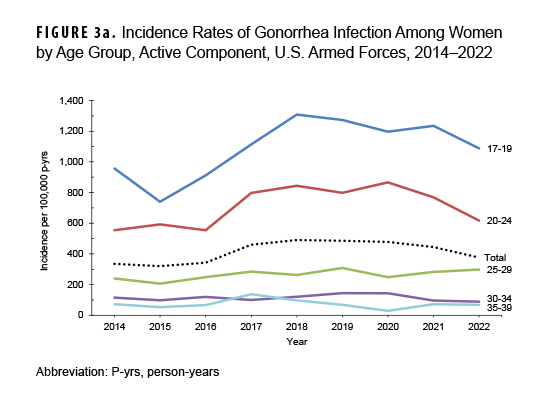
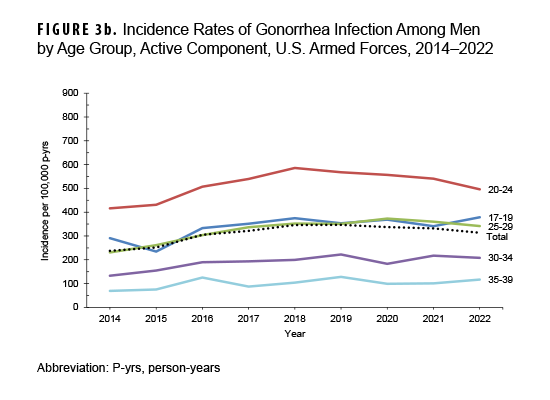
These recent trends in declining female gonorrhea incidence were primarily driven by rates among service members under age 25. While male gonorrhea rates declined for those 20-24 years of age during the last 5 years, the rates among men under age 20 and ages 25-29 remained relatively stable. Gonorrhea rates remained highest among non-Hispanic Black service members throughout the surveillance period, peaking at 1,229.3 per 100,000 p-yrs in 2020 and declining to 984.9 per 100,000 p-yrs in 2022 (data not shown).
Syphilis
The crude incidence rate for total cases of syphilis in 2022 (73.5 per 100,000 p-yrs) almost doubled the rate observed in 2014 (40.7 per 100,000 p-yrs). After a period of brief decline starting in 2019, rates increased by nearly 40% from 2020 to 2022. During this 3-year period, the 61.1% increase in female syphilis rates (37.8 to 60.9 per 100,000 p-yrs) exceeded the 35.8% increase among men (56.1 to 76.2 per 100,000 p-yrs) (Figure 4a; Figure 4b).
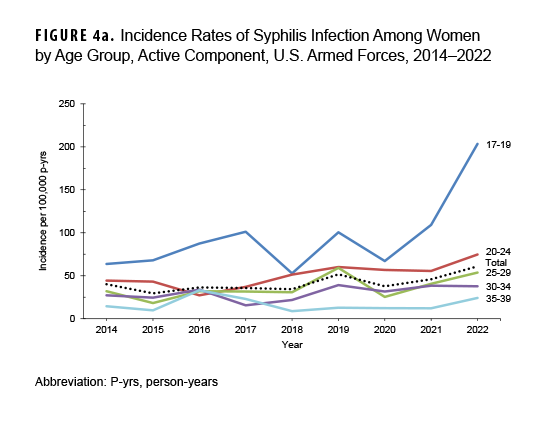
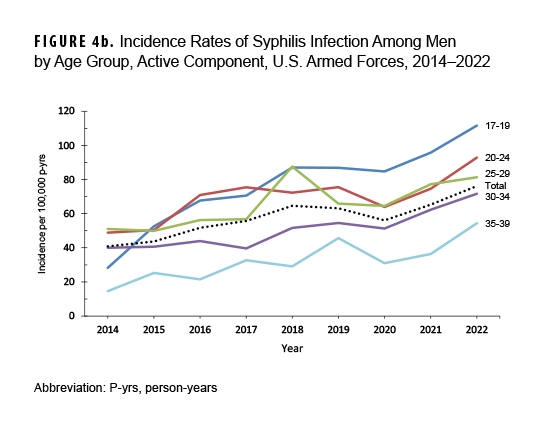
Overall incidence rates of syphilis generally decreased with advancing age among both sexes; this pattern was consistent among all racial/ethnic groups. Non-Hispanic Black service members consistently accounted for the highest rates of syphilis throughout the surveillance period, with women under 25 years of age (122.6 per 100,000 p-yrs), men under age 25 (254.4 per 100,000 p-yrs), and men ages 25-34 (201.7 per 100,000 p-yrs) substantiating the largest rates stratified by age and biological sex within this racial/ethnic group in 2022 (data not shown).
Genital HPV
The crude annual incidence rates of genital HPV infections decreased 47.3% among all active component service members from the start of the surveillance period until the end, with the most marked absolute decrease among women. Incidence rates of genital HPV infections among female service members decreased from a high of 2,559.0 cases per 100,000 p-yrs in 2014 to a low of 1,406.6 cases per 100,000 p-yrs in 2022 (45.0%) (Figure 5a). While this crude decline was observed for all age groups, the rate of genital HPV among females 30-34 years old increased at 3 points annually during the surveillance period. The rate of genital HPV among males remained substantially lower than among women throughout the surveillance period, also demonstrating a major decline from 307.3 HPV cases per 100,000 p-yrs 2014 to 122.1 cases per 100,000 p-yrs in 2022 (60.3%). Beginning in 2020, genital HPV rates in men older than age 34 increased (Figure 5b).
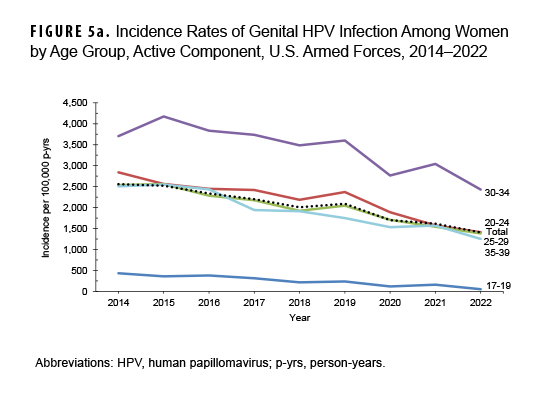
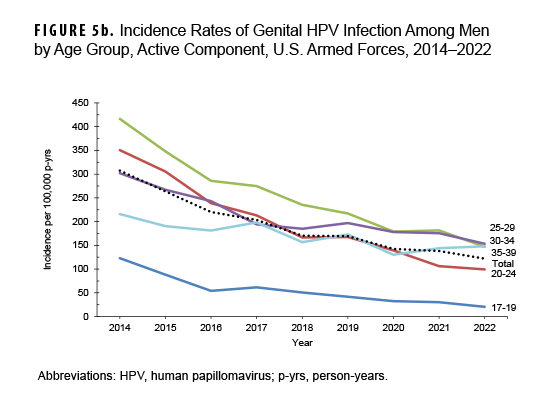
Genital HSV
Crude annual incidence rates of genital HSV infections decreased from 237.9 to 158.2 per 100,000 p-yrs over the course of the surveillance period (33.5%). Rates among female service members ranged from a high of 782.8 per 100,000 p-yrs in 2016 to a low of 434.0 per 100,000 p-yrs in 2022. During the last 5 years of the surveillance period, genital HSV rates among female service members declined by approximately 40% for all age groups except women ages 35-49, who had a more stable rate reduction of 22.3% (Figure 6a). Rates for male service members were also highest in 2016 (181.8 per 100,000 p-yrs) and lowest in 2022 (101.5 per 100,000 p-yrs). Men ages 20-24 demonstrated the largest HSV rate decline, of 38.6%, from 2018 to 2022 (Figure 6b).
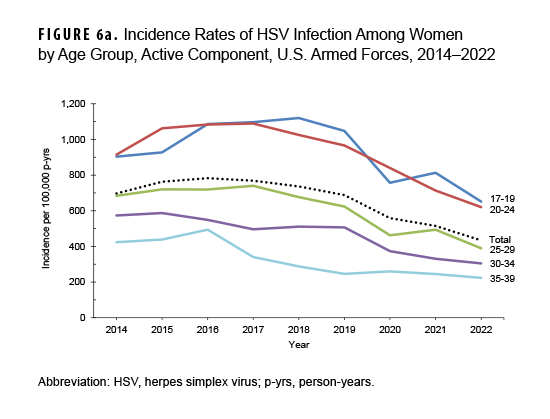
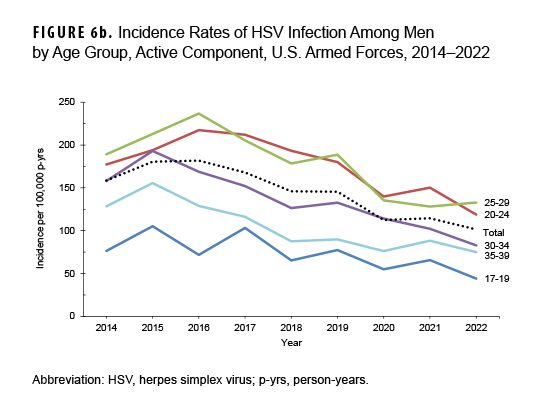
Over the surveillance period, the incidence rates of genital HSV infections decreased among service members in all age and racial/ethnic groups (data not shown).
Discussion
This surveillance report documents a continued period of decline since 2019 for all STI case rates, with the exception of syphilis. After a brief decline in 2019, the incidence rate of syphilis among male and female active component service members increased by approximately 40% between 2020 and 2022. As noted by CDC national surveillance reports, the COVID-19 pandemic likely contributed to changes in STI screening coverage; thus, incidence rates during this time should be interpreted with caution.14 Future analyses of STI screening practices for active component service members may help elucidate true incidence rate declines, particularly for STIs more commonly associated with asymptomatic infection.
While age- and gender-adjusted STI rates among active duty service members remain elevated when compared to U.S. rates, this comparison is subject to unmeasured sociodemographic differences and case surveillance methodologies unique to each population. The U.S. military represents a ‘healthy worker’ population with no-cost access to complete preventive and primary care, for maintenance of a medically ready force.15 The electronic health records generated by the Military Health System (MHS) also enable more complete disease burden capture for notifiable disease reporting. The data source descriptions for chlamydia, gonorrhea, and syphilis in this report are provided to clarify the percentage of cases identified by sources supplemental to medical event reports.
Chlamydia rates were marked by a pronounced decline from 2019 to 2022, substantiated by distributed rates of decline by biological sex and all racial/ethnic groups among service members 25 years of age or younger. An assessment of screening rates may clarify whether this constituted a true decline in incidence, as chlamydia rates in the general population continued to increase during this period.4 Compared to most recently published 2021 national statistics, the chlamydia case rate for service members 20-24 years of age remains elevated in relation to the general population for both male (2,556.2 service members vs. 1,680.0 civilians per 100,000) and female (7,466.4 service members vs. 3,797.8 civilians per 100,000) rates among the same age group.16 These rate comparisons should, however, be interpreted with an understanding of the unique surveillance methods for each population, as well as their differences in screening access and use. Laboratory and medical encounter data from service members in 2022 supplemented chlamydia case rates by 13%; these cases had no medical event reports and would not have been identified without supplemental electronic health record data.
While the national gonorrhea rate for civilians has continued to increase since its historic low in 2009, gonorrhea case rates among both male and female service members of the youngest age groups have reduced, with male service members ages 25-29 demonstrating a relatively stable rate of decline. Recently published national statistics for 2021 demonstrate relatively equivalent gonorrhea case rates for female service members and female civilian populations ages 20-24 (768.9 service members vs. 873.2 civilians per 100,000), while gonorrhea case rates among male service members 20-24 years of age were lower (540.5 service members vs. 844.2 civilians per 100,000) during the same year.17 These rate comparisons should be interpreted in concert with aforementioned case detection and surveillance methods, as 29% of the gonorrhea cases among service members in this report were identified from supplemental laboratory or medical encounter data.
Routine surveillance reports do not assess anatomic sites from gonorrhea case reports or laboratory records, which could provide more comprehensive understanding of extragenital infections in high-risk populations. National guidelines recommend screening for gonorrhea, including pharyngeal or rectal testing, at least annually for MSM and HIV-positive patients. Extragenital gonorrhea screening may be considered for females on the basis of reported sexual behaviors and exposure.18 Despite these recommendations, extragenital screening for high-risk civilian and military populations is underused.19,20 A recent assessment of extragenital STI screening by primary care physicians for HIV-positive airmen found that approximately one-third of patients had undetected STIs, the majority due to extragenital infections of the rectum and pharynx.20
A male-to-female syphilis rate ratio greater than 1 persisted throughout the surveillance period; meanwhile a recent relative increase in syphilis rates among female service members, particularly within the youngest age group, could indicate either improved accession screening or a true increase in rates among women. This finding is reflected in national surveillance reports: Although civilian rates of primary and secondary syphilis are lower among women, female incidence rates more than doubled from 2016 to 2020.21 This evidence reinforces U.S. Preventive Services Task Force recommendations on early screening for syphilis infection in all pregnant women, particularly for female military service members, who are largely within child-bearing years.22
No data on sexual risk behaviors were available, but prior surveys of military personnel have indicated increased behaviors of possible concern. The 2018 Department of Defense Health-Related Behaviors Survey (HRBS) documented that 19.3% of active component respondents reported 2 or more sexual partners within the past year, and 34.9% reported sex with a new partner without condom use in the past year; these percentages are almost double those from the 2011 survey.23
This report has several limitations that should be considered when interpreting its results. First, STI diagnoses could be incorrectly coded. For example, STI-specific “rule out” diagnoses or vaccinations (e.g., HPV vaccination) may be reported with STI-specific diagnostic codes, which would result in overestimation of STI incidence. Cases of syphilis, genital HSV, and genital HPV infections based solely upon laboratory test results are considered “suspect” because laboratory test results cannot distinguish between active and chronic infections. Because incident cases of those STIs were identified based upon a first qualifying encounter or laboratory result, it is likely most cases were acute and not chronic.
STI cases coded in the medical record using symptom codes (e.g., urethritis) rather than STI-specific codes may not be captured. In addition, the counts of STI diagnoses reported here may underestimate actual diagnoses because some affected service members may have been diagnosed and treated by non-reimbursed, non-military care providers (e.g., county health departments or family planning centers) or in deployed settings (e.g., overseas training exercises, combat operations, or aboard ships). Laboratory tests provided through Click to closePurchased CareThe TRICARE Health Program is often referred to as purchased care. It is the services we “purchase” through the managed care support contracts.purchased care or from a shipboard facility, battalion aid station, or in-theater facility were not captured by the current analysis. Finally, medical data from July 2017 to October 2019 at sites using the new MHS electronic health record, MHS GENESIS, are not available in the DMSS—these sites include Naval Hospital Oak Harbor, Naval Hospital Bremerton, Air Force Medical Services Fairchild, and Madigan Army Medical Center. Medical encounter data for individuals seeking care at any of those facilities between July 2017 and October 2019 could not be included in the current analysis.
For some STIs, detection of prevalent infection may occur long after an initial infection. Changes in incidence rates may reflect, at least in part, temporal changes in case detection, including shifts to more aggressive screening. The lack of standard service and installation practices for STI screening, testing, treatment, and reporting complicate interpretations of the differences between services, military and demographic subgroups, as well as locations. Establishing STI screening, testing, treatment, and reporting standards throughout the services, and ensuring adherence, would likely improve detection and characterization of STI-related health threats. Continued behavioral risk-reduction interventions are still required to counter STIs among military service members.
References
- Armed Forces Health Surveillance Center. Absolute and relative morbidity burdens attributable to various illnesses and injuries, active component, U.S. Armed Forces, 2021. MSMR. 2022;29(6):2-9.
- National Academies of Sciences, Engineering and Medicine. 2021. Sexually Transmitted Infections: Adopting a Sexual Health Paradigm. Washington, DC: The National Academies Press. Accessed March 28, 2023. https://pubmed.ncbi.nlm.nih.gov/34432397
- Boyer CB, Gaydos CA, Geller AB, et al. Sexually transmitted infections in the U.S. military: a sexual health paradigm to address risk behaviors, unintended pregnancy, alcohol use, and sexual trauma. Mil Med. 2022;187(5-6):140-143.
- Centers for Disease Control and Prevention. Preliminary 2021 STD Surveillance Data. Accessed March 28, 2023. https://www.cdc.gov/std/statistics/2021/default.htm
- Krupp K, Madhivanan P. Antibiotic resistance in prevalent bacterial and protozoan sexually transmitted infections. Indian J Sex Transm Dis AIDS. 2015;36(1):3-8.
- Growing antibiotic resistance forces updates to recommended treatment for sexually transmitted infections [news release]. Geneva, Switzerland: World Health Organization. August 30, 2016. Accessed February 23, 2021. https://www.who.int/news-room/detail/30-08-2016-growing-antibiotic-resistance-forces-updates-to-recommended-treatment-for-sexually-transmitted-infections
- Tien V, Punjabi C, Holubar MK. Antimicrobial resistance in sexually transmitted infections. J Travel Med. 2020;27(1):1-11.
- Kreisel KM, Spicknall IH, Gargano JW, et al. Sexually transmitted infections among US women and men: prevalence and incidence estimates, 2018. Sex Transm Dis. 2021;48(4):208-214.
- Garland SM, Steben M, Sings HL, et al. Natural history of genital warts: analysis of the placebo arm of 2 randomized phase III trials of a quadrivalent human papillomavirus (types 6, 11, 16, and 18) vaccine. J Infect Dis. 2009;199(6):805-814.
- Armed Forces Health Surveillance Center. Sexually transmitted infections, active component, U.S. Armed Forces, 2000–2012. MSMR. 2013;20(2):5-10.
- Armed Forces Health Surveillance Division. Sexually transmitted infections, active component, U.S. Armed Forces, 2013–2021. MSMR. 2022;28(3):13-22.
- Garges E, Stahlman S, Jordan N, Clark LL. P3.69 Administrative medical encounter data and medical event reports for syphilis surveillance: a cautionary tale. Sex Transm Infect. 2017;93(suppl 2):A118.
- Armed Forces Health Surveillance Branch. Use of ICD-10 code A51.31 (condyloma latum) for identifying cases of secondary syphilis. MSMR. 2017;24(9):23.
- Centers for Disease Control and Prevention. National Overview of STDs, 2020. Accessed March 28, 2020. https://stacks.cdc.gov/view/cdc/125947
- Tanielian T, Farmer C. The US Military Health System: promoting readiness and providing health care. Health Affairs. 38(8):1259-1267.
- Centers for Disease Control and Prevention. Sexually Transmitted Disease Surveillance 2021, Table 4: Chlamydia–Reported Cases and Rates of Reported Cases by Age Group and Sex, United States, 2017-2021. Accessed April 27, 2023. https://www.cdc.gov/std/statistics/2021/tables/4.htm
- Centers for Disease Control and Prevention. Sexually Transmitted Disease Surveillance 2021, Table 9: Gonorrhea–Reported Cases and Rates of Reported Cases by Age Group and Sex, United States, 2017-2021. Accessed April 27, 2023. https://www.cdc.gov/std/statistics/2021/tables/9.htm
- Workowski KA, Bachmann LH, Chan PA. Sexually transmitted infections treatment guidelines, 2021. MMWR Recomm Rep. 2021;70(4):1-187.
- Li J, Armon C, Palella FJ, et al. Chlamydia and gonorrhea incidence and testing among patients in the Human Immunodeficiency Virus Outpatient Study (HOPS), 2007-2017. Clin Infect Dis. 2020;71(8):1824-1835.
- Yabes JY, Lamb CC, Hakre S, et al. Provider uptake of extragenital screening for gonorrhea and chlamydia in a cohort of Air Force members with incident HIV diagnosis. Medicine. 2022;101(42):e31209.
- Centers for Disease Control and Prevention. Sexually Transmitted Disease Surveillance 2021. Table 15. Primary and Secondary Syphilis–Reported Cases and Rates of Reported Cases by Age Group and Sex, United States, 2017-2021. https://www.cdc.gov/std/statistics/2021/tables/15.htm
- U.S. Preventive Services Task Force, Curry SJ, Krist AH, Owens DK, et al. Screening for syphilis infection in pregnant women: US Preventive Services task force reaffirmation recommendation statement. JAMA. 2018;320(9):911-917.
- Meadows SO, Engel CO, Collins RL, et al. 2018 Department of Defense Health Related Behaviors Survey (HRBS): Results for the Active Component. Sexual Behavior and Health. RAND Corporation Report. Accessed March 16, 2022. https://www.rand.org/pubs/research_reports/RR4222.html